
|
|
| www.wildfirenews.com | |
MESA FIREFIGHTER GETS KIDNEY FROM COLLEAGUEOCTOBER 10 -- MESA, AZ: They say firefighters are all one big family; the bonds among firefighters are legendary and any of them will tell you about it. But several Mesa firefighters recently showed just how deep that family runs when they volunteered to sacrifice a kidney for a co-worker. The Arizona Republic reported that yesterday morning, a 16-year department veteran (who has asked to remain anonymous) underwent more than two hours of surgery to donate a healthy kidney and a new lease on life to Capt. John Delaney. Another veteran Mesa firefighter estimated that the donor was one of 25 who stepped forward. "That is a tremendous act of love, and it doesn't surprise me that a firefighter would do this," Mesa Fire Chief Dennis Compton said. "And that is an example of how strong the bond is between firefighters." Both the donor and Delaney, who have worked together for years, were reported doing well after the transplant. Delaney has received dialysis treatment for nine months and has been suffering from diabetes and hypertension for two years. Other firefighters and their families are pitching in, making meals and providing assistance to Delaney and the donor's families. FIRE RISK: BEETLE-KILLED PINES IN SOUTHERN CALIFORNIA RESORT AREASOCTOBER 10 -- SAN BERNARDINO, CA: Thousands of trees killed by beetles pose a major fire danger to the mountain resorts of the San Bernardino National Forest, according to an AP story published by the Sacramento Bee. Forestry officials estimate at least 35,000 trees, mostly pines, have died recently from beetle infestations. "There's at least twice as many trees dying as we had last year," said Jon Regelbrugge, Lands and Resource Officer with the San Bernardino. He mapped tree mortality in San Bernardino and western Riverside counties in late August. The tree deaths pose a serious fire threat in coming weeks if nothing is done; San Bernardino and Riverside counties have each budgeted $300,000 for clearing dead trees from private property. But some residents and forestry experts believe the state and federal governments have not done their part. "Lake Arrowhead is going to burn down," said Richard Minnich, a fire ecology professor at the University of California, Riverside. But restrictions on the use of federal disaster funds -- and concerns about subsidizing private property owners -- have hampered the efforts of state and federal agencies. "The beetles have gone wild, in unprecedented numbers," said botanist Tim Krantz, a University of Redlands professor of environmental studies. "I've worked in the forest 25 years, and I've never seen anything like this. I dare say no forester or botanist living has ever seen anything like this in southern California." "This is a long-term problem," said Jim Wright, CDF deputy director. "They'll have to be cutting these trees forever to get caught up." DEMOCRATS WITHDRAW SUPPORT FOR WILDFIRE LEGISLATIONOCTOBER 09 -- WASHINGTON, DC: A House committee approved a bill yesterday to reduce the threat of wildfires, but key Democrats withdrew their support, according to an AP story in the Seattle Times. That leaves uncertain the prospects for wildfire legislation this year. Rep. George Miller of California and Rep. Peter DeFazio of Oregon last week endorsed the legislation, which Republicans had hoped would help move the bill through the Senate. But after intense negotiations, Miller and DeFazio backed out. They said the proposal was too sweeping. Rep. Scott McInnis of Colorado, who sponsored the bill, said he's committed to continuing negotiations. "In a collaborative effort to reach consensus," McInnis said last week, "my staff and I have sat down for several hours a day for the past few weeks to hammer out a consensus plan to address the threat of wildfire, working with longtime environmental proponents like Representatives George Miller and Peter DeFazio." He explained that the amendment applies to fuels reduction projects on National Forest and BLM lands. It is limited to lands in the wildland/urban interface, municipal watersheds, T&E species habitat, and lands where forest health is threatened by windthrow, blowdown, large-scale disease, or insect infestation. House and Senate Republicans have joined President Bush in demanding accelerated fuels reduction projects, but Democrats and environmentalists argue that the proposals undermine environmental protections and would benefit timber companies. The McInnis proposal would streamline environmental studies and tighten deadlines for appeals. HOTSHOTS IN HOT WATER OVER HOT (BUT NOT NAKED) PHOTOSOCTOBER 09 -- SANTA BARBARA, CA: Twenty hotshots based at the Los Prietos Ranger Station on the Los Padres National Forest are in the middle of the latest in a long series of sexual harassment controversies within the Forest Service in California. According to a report by the L.A. Times, the Forest Service is trying to figure out what to do about some photos of "scantily clad" women in the hotshots' crew buggies. Forest Supervisor Jeanine Derby, meanwhile, was tagged for investigation in a report released yesterday by Public Employees for Environmental Responsibility. The report concludes that Derby should be investigated for her "hostility" to historic preservation and her "retaliation against outspoken cultural resources personnel."
Lesa Donnelly worked for the Forest Service for 22 years before resigning from the agency earlier this year. She was until June also a member of the regional monitoring council that tracks the agency's approach to sexual harassment claims. "The pictures have given us tangible evidence of what we have been saying for years," she said. "The tone is set by management, and there are sexual harassment issues all over California." Donnelly said the Los Padres has one of the biggest problems, and that the hotshots are not professional. "They have brought shame on the entire Forest Service," she said. Almost two weeks after the complaint about the photos in the buggies, Regional Forester Jack Blackwell called the photos offensive and added that "this behavior is intolerable." Last week he ordered one-hour sessions for all 8,300 agency personnel in California "to ensure that all employees understand our zero-tolerance policy."
But that wasn't enough for Donnelly and other entrenched critics. She said it took almost two weeks for Blackwell to announce his actions. "He's not doing anything to work with us to get the supervisors to really take this seriously," she said. "At Los Prietos, one supervisor started off by telling everybody she knew they all worked hard and played hard. That wasn't the tone to take. It was a way of winking and saying, 'I really don't care.'" Donnelly says the crew should be disbanded and management officials disciplined or replaced. Along with the secretly taken pictures of the semi-nude photos, there were photographs inside the crew barracks showing stacks of six-packs of beer. "They really think they are the hottest thing around, and they act like they are a bunch of frat boys," Donnelly said. "They also have started intimidating people since this controversy started. I am going to ask Forest Service officials in Washington that they be removed for the safety of the people they think are talking about them." "I am afraid somebody is going to get hurt, and it could be me," said Janine McFarland, an archaeologist who says she was removed from a Chumash Indian project because of her complaints. "I'm very concerned for my safety."
Over the last three years, 26 Los Padres employees have filed 58 claims of harassment and reprisal against Derby and other forest managers. McFarland has filed at least 15 of the claims and said she felt vindicated by the discovery of the photos. "We've been trying to say all of this is going on," she said. "This is the environment we live in and what management fosters in their attitude towards women." The Sacramento Bee reported that forest employees claim the Los Padres National Forest is being neglected and damaged, and they fear retaliation if they decide to complain, according to an 18-page report by a national watchdog group Public Employees for Environmental Responsibility. The report blames Forest Supervisor Jeanine Derby, and says she has violated federal law by promoting recreational uses of the forest at the expense of its cultural resources. It describes how Forest archaeologists disclosed numerous violations to the State Office of Historic Preservation in the mid-1990s. Derby and other Forest leaders allegedly retaliated against the whistleblowers, relieving them of their responsibilities and replacing them with less experienced but obedient employees. "These things disappoint me because there are other avenues for employees to take their complaints," said Derby, who denied the accusations. Former employees and volunteers, some anonymous, were critical of management's attempt at forest preservation. Derby's supervisors say she is doing a good job. "At the regional office we are confident that Los Padres National Forest will work through these controversies," said Matt Mathes, media relations officer at the regional office. "Jeanine is a fine forest supervisor and she has a challenging job. These forests are often over 1 million acres and people care passionately about what happens there." DEVELOPMENT AND FUELS RUN UP THE TABOCTOBER 02 -- KALISPELL, MT: Buildups of hazardous fuels and increasing development in the wildland/urban interface are the root causes of rising fire suppression costs, a study commissioned by Congress concludes. The National Academy of Public Administration in Washington, DC, yesterday released its study, according to a report by the Daily Inter Lake. The report includes case studies of six fires from summer 2001. The panel concluded that there are no easy budgetary fixes for fire costs that have jumped dramatically over the last decade. Studies that find ways to trim costs don't make a significant difference; wildfires now are bigger and threatening more homes than ever before, said Bruce McDowell, the academy's study coordinator. "Budget cuts become fiction by the time you get to reality in the fire season," McDowell said. "If you look at the overall issue and the size of it, it's not really susceptible to direct attack, to put it in fire terms. We didn't think you could do a whole lot there. We think an indirect attack, where you go after your root causes, will pay off in the long run." Costs in the year 2000 reached an unprecedented $1 billion, and rose to $1.6 billion this year. "The two primary causes are the massive accumulation of hazardous fuels in the nation's wildlands and the increasing community development occurring in and near them," the report says. Prolonged drought is also a major but uncontrollable factor in big-spending fire years. The panel recommends requiring local fire protection efforts to meet certain standards, with the incentive of receiving money from the National Fire Plan and the new FEMA disaster mitigation program. The report also recommends streamlined procedures for fuels reduction projects, and the panel said the focus should be on high-hazard areas inside and closest to a community, including municipal watersheds. The study was requested by the House and Senate Appropriations Committees through the U.S. Forest Service and the Department of Interior.
GS-7 ASSISTANT ZONE FIRE MANAGEMENT OFFICERS NEEDEDOCTOBER 08 -- SKYKOMISH, WA: The Mount Baker-Snoqualmie National Forest will be filling two positions for GS-7 Assistant Zone Fire Management Officer; one position is located in Darrington and the other position is at Skykomish. These position will be advertised under both Merit Promotion and Demo, and this is the second outreach for the positions. Duties include assisting the Zone Fire Management Officer with fire and fuels management activities. Responsibilities include preparedness, training, supervision, and direction of zone fire suppression and fuels resources, along with upkeep and maintenance of fire suppression equipment. Persons in these positions also assist the FMO in other training, situation and availability reporting, maintaining training records, scheduling training, work capacity testing, fire refresher training, fire reviews, and RAWS maintenance. Announcements for this position will be posted on the OPM website under series 0462, and an outreach notice is online in WORD format. For more information call Dave Johnson at (425)744-3510 or email him at [email protected]
RESIDENTS LEARNED FROM CROY FIREOCTOBER 08 -- MORGAN HILL, CA: Almost two weeks after the Croy Fire burned through the mountains and hillsides they call home, local residents gathered at the community's volunteer fire station Sunday; they discussed the need for more firefighting resources, improving communications, and homeowners' responsibility for defensible space. The San Jose Mercury News reported that the meeting took place the day after fire managers declared Santa Clara County's third-largest wildfire fully controlled. The Croy Fire burned more than 3,000 acres in the Santa Cruz Mountains west of Morgan Hill and destroyed 34 homes. Residents who gathered at the Ormsby fire house talked about ways to improve communication so fire personnel have a better chance of controlling a fire before it gets away. Volunteer departments are often the first to respond because they're the closest, but by linking with fire personnel from CDF they can combine resources and be more effective, said Libby Sofer, who works with the Ormsby Fire brigade. Those gathered also talked of the need for residents to take responsibility for maintaining the areas around their homes. "It's the homeowner's responsibility to clear the property," said Sofer. She said a second meeting on October 15 will include speakers from the U.S. Small Business Administration, the American Red Cross, the California Department of Forestry and Fire Prevention as well as Santa Clara County Supervisor Don Gage, who represents residents in the fire-ravaged area. The Croy Fire caused more than $4.4 million in damage. There were no deaths and only 10 minor injuries to fire personnel. The fire involved more than 2,000 firefighters, 120 engines, and 13 helicopters. It cost $8.8 million. CONE FIRE STUDIED AS IT BURNED EXPERIMENTAL FORESTOCTOBER 02 -- SUSANVILLE, CA: The Cone Fire that started September 26 on the Lassen National Forest is providing wildland fire experts and forestry researchers a good look at the effects of fuels reduction treatments on an active wildfire -- and the fire's effects on the forest ecosystem.
The Blacks Mountain Experimental Forest is an active research project and is one of the few forests in the country with more than 50 years of recorded data. Experimental treatments were conducted on 12 plots of 250 acres each. The plots were mechanically thinned, and half were treated with prescribed fire. About 1,600 acres of the 2,000-acre Cone Fire burned in the Blacks Mountain Experimental Forest. The Forest Service's Pacific Southwest Station scientist Bill Oliver, along with Eagle Lake District Ranger Bob Andrews and District Silviculturist Al Vazquez, surveyed the burned portions of the experimental forest. They reported that high-intensity burns occurred in areas of the forest that had not been treated. The timber stands that were thinned or prescribed-burned or both, though, saw mostly low-intensity ground fire, resulting in lower tree mortality. The fuels reduction treatments slowed down -- and in some cases even stopped -- the fire. Oliver said that the Cone Fire gives scientists an opportunity to evaluate and record the effects of the fuels treatments on areas later burned by wildfire. In November, Oliver will bring a scientific team to the burned treatment areas to assess the effects. "We need to analyze the treated and untreated areas that burned and document those findings," said Oliver. Tours of the area can be arranged by calling Cone Fire Information at (530)257-3719 or the Susanville Interagency Fire Center at (530)257-5575. The Cone Fire website is online courtesy of the Lassen National Forest, and more information on the Blacks Mountain Experimental Forest is online at redding.psw.fs.fed.us/bmef.html COLORADO NOT OUT OF THE WOODSSEPTEMBER 30 -- DENVER, CO: Fall has come to the high country in Colorado, along with a half million hunters and campers and hikers, but the state's fire danger is a long ways from over. Though Gov. Bill Owens recently lifted a statewide ban on open burning, that doesn't apply to some Forest Service and BLM lands. After a drought like the state experienced this year, reported the Rocky Mountain News, fire managers are still on the alert as hundreds of thousands of people head for the high country. "We've had some good rains, especially in the southern part of the state, but north of Interstate 70 things are still extremely dry," said Denise Tomlin, a fire prevention specialist for the Forest Service. "A lot of times people think once the heat of the summer is over, the fire danger is over. But many major fires have taken place in September and October." Todd Malmsbury with the state Division of Wildlife said they expect 500,000 hunters in the hills between September and mid-December. "A number of them will be from out of state, and may not be aware of the drought this year," he said. The agencies are posting signs about dry conditions and fire danger in government offices and sporting goods stores. "We have posted fire information along with our regular big game information on our website," Malmsbury said. "Hunters can log on to www.wildlife.state.co.us, click on hunting and then on the fire info section." Tomlin said agencies are concerned about not just campfire escapes, but also ignitions caused by ATVs and 4-wheel-drive vehicles that are used off-road and in dry grasses. He said they are reminding people not to park vehicles on tall, dry grass or duff because catalatic converters are extremely hot and can ignite dry materials. PANEL SCRUTINIZING AIRTANKERSSEPTEMBER 29 -- RENO, NV: The aging aircraft that fight wildfires under federal contract for the Forest Service have been under scrutiny before. But none of the audits or probes or letters had the impact of the horror caught by a Reno television news crew this summer when an airtanker's wings snapped off in mid-air. The video of the plane plunging to the ground in flames, killing all three men on board, transfixed television viewers nationwide. A month after the June 17 crash near Walker, California, another airtanker crashed near Rocky Mountain National Park in Colorado, killing both crew members. An Associated Press story in the San Diego Union-Tribune reported that a newly created "blue ribbon panel" is conducting a thorough review of the agency's aerial firefighting program. The NTSB said shortly after the crashes this summer that fatigue cracks were found in the wings of both planes, and investigators are looking closely at the cracks and other safety issues to determine whether they caused the wings to fail. This month, NTSB officials said preliminary tests showed metal fatigue was not evident over the entire wing in either plane, but that crack detection techniques may have been unreliable. Forest Service Chief Dale Bosworth has charged the new panel with reviewing "safety, operational effectiveness, costs, sustainability and strategic guidance." The panel plans to collect input at regional meetings. Besides the five remaining C-130As in the fleet, the agency also is reviewing other firefighting aircraft, including the 19 Beechcraft Barons it owns for use as lead planes. The panel has scheduled meetings at Portland, Salt Lake City, Denver, Albuquerque, and Sacramento. Written comments can be submitted to the panel at the meetings or can be emailed to [email protected] or faxed to (801)517-1021 or mailed to the Aerial Wildland Firefighting Panel at PO Box 221150, Salt Lake City, Utah 84116. FIREFIGHTERS WRAP UP OREGON FIRESSEPTEMBER 28 -- HOOD RIVER, OR: Forest fires near Bridal Veil and Estacada were nearly contained yesterday, slowed in part by cooler and more humid weather, according to a report by the Oregonian. The 285-acre Bowl Fire near Estacada should be fully contained by this evening, thanks to a fresh infusion of about 100 firefighters, calm weather, high humidity, and a successful burnout yesterday afternoon.
"They very doggedly kept after the burnout to keep it going," Turner said. Predicted east winds never arrived. In the Columbia River Gorge, firefighters were mopping up the Oneonta Fire, which was still less than an acre in size. The fire started near Bridal Veil on Thursday, about five miles east of Multnomah Falls, said Stan Hinatsu with the Columbia River Gorge National Scenic Area. Hinatsu said the fire was human-caused, but that officials were still investigating; the fire started in a 20-foot-high pile of logs that had accumulated in the gorge after washing over a waterfall during rainstorms.
CONE FIRE APPROACHES 2,000 ACRES
Officials at the Susanville Interagency Fire Center said tinder-dry conditions and very low relative humidity are contributing to the spread of the fire, which started Thursday afternoon. The fire's been torching through the forest canopy, and spot fires have been reported a quarter-mile ahead of the main fire front. No cause has been determined. Six airtankers and five helicopters were on the fire yesterday, along with 17 engines, 12 hand crews, and six water tenders. More resources have been ordered and are en route. Fire officials said the fire illustrates that extreme fire dangers are still present in northern California forests and wildlands. "We have had no measurable, widespread rain through the summer," said Chuck Judd, co-manager at the fire center. "Continuing low humidity contributes to the fire danger. The relative humidity was four percent when this fire started, and was only 16 percent after midnight." Current fire information is available online or by calling the fire center at (530)257-9553.
ENVIROS SUE TO STOP THINNING NEAR LAKE TAHOESEPTEMBER 28 -- RENO, NV: Environmental groups filed a lawsuit yesterday to block federal logging near Lake Tahoe that they say will increase and not reduce wildfire risk. The salvage logging planned across 1,700 acres of the Eldorado National Forest, according to a report in the Modesto Bee, would recover standing dead timber, restore burned soils, and reduce fuels after a 17,000-acre fire that burned through the area in August 2001. The suit says the Forest Service didn't fully comply with NEPA requirements to analyze the effects of such projects. "They have this backward," said Rachel Fazio, a lawyer for the John Muir Project, which sued on behalf of the Earth Island Institute and Center for Biological Diversity. "They are taking the least flammable material -- the largest trees that provide the shade. They are leaving all the fuels, the small trees and slash. They are going to increase fire risk pretty significantly." Frank Mosbacher with the Eldorado National Forest said the agency had not seen the lawsuit and couldn't comment on it. But he said the project is part of a comprehensive effort to restore forest health. "A significant part of the whole analysis was to make sure whatever we do out there will reduce the fire hazard in the short term," he said. The lawsuit says the Forest Service grossly overestimated the area that experienced a high-intensity burn. It says many of the trees marked for logging are within suitable habitat for the California spotted owl and should be protected under guidelines prohibiting logging of any trees larger than 20 inches diameter. Restoration plans for the Star Fire are on the Eldorado National Forest website. RUMORS: METH LAB IGNITED CROY FIRE?SEPTEMBER 28 -- MORGAN HILL, CA: Rumors that a trailer methamphetamine lab started the destructive Croy Fire last Monday have not been substantiated by the Santa Clara County Sheriff's Department, which is investigating the fire's cause. Fire investigators with CDF determined that the fire did start in or near a single-wide trailer near Uvas Canyon County Park, and Pam Rhotin with CDF said yesterday she's heard the rumors that a methamphetamine lab could have sparked the fire. But according to the Bay Insider, the Santa Clara County Sheriff's Department has been unable to confirm the speculation. Rhotin also said that RH of more than 80 percent Thursday night and yesterday morning has helped firefighters in their efforts. "The fog really helps,'' she said. "The fuel doesn't burn as hot or as quickly when it's damp.'' The fog did, though, limit visibility enough to restrict activity of airtankers. The San Francisco Chronicle reported that sheriff's investigators yesterday were questioning residents who lived near the trailer. The agency defended itself against criticism that firefighters, worried about the explosive chemicals and booby traps often associated with drug labs, hesitated before attacking the fire. Residents complained that a delay allowed the fire to rage out of control. But dispatch logs released by CDF show the fire was reported at 1:50 p.m. A battalion chief, two airplanes, a helicopter, and three engines were dispatched within 38 seconds. The helicopter arrived at 2:03 p.m., followed within eight minutes by the airtankers. Engines first arrived at 2:39 p.m. More than 3,100 acres, 28 homes, and 15 other structures have burned since the Croy Fire started Monday afternoon.
35,200-ACRE WILLIAMS FIRE NOW 35 PERCENT CONTAINEDSEPTEMBER 28 -- LOS ANGELES, CA: Two firefighter injuries were reported yesterday on the Williams Fire on the Angeles National Forest; one firefighter had an adverse reaction to poison oak treatment and was hospitalized, another from the Six Rivers National Forest sustained an ankle injury. The fire's spread has decreased some with favorable weather, and yesterday was reported as mostly slow spreading surface fire with occasional intense runs upslope in the afternoon. The fire did make a small run in the Susanna Canyon area. Firefighters last night were building line and preparing burnouts in Branch 1 and conducting firing operations in Branch 2 near Mount Baldy Village. The firing operations are expected to take two days; helitankers will support the operations and provide structure protection. The cause of the fire is as yet undetermined; suppression costs have run $11 million so far. Fireline has been completed around the slopover across Cattle Creek, and line has been started up the east flank on the slopover across the East Fork. The fire continues to move east along Cattle Canyon, threatening the Sheep Mountain Wilderness. Current information's available on the Williams Fire website or by calling (626)821-6700.
OREGON FIRE HAZARD: ROLLING ROCKSSEPTEMBER 27 -- HOOD RIVER, OR: Cooler weather yesterday continued to help crews working on the 241-acre Bowl Fire outside Estacada, but a second firefighter was injured by falling rocks on a new fire near Bridal Veil in the Columbia River Gorge. The Oregonian reported that firefighters were battling a stubborn two-acre fire in a popular hiking area about five miles east of Multnomah Falls yesterday afternoon.
"The terrain is not very forgiving and very steep," said Ferris. He said one firefighter was injured by falling rocks; another firefighter was injured Saturday on the Bowl Fire when flames burned away underbrush and sent torrents of rock into the Clackamas River. "The concern was keeping the fire from getting up to the top of the cliffs and running away from us," said Ferris. The fire started in a 20-foot-high pile of logs that had accumulated in the gorge after washing over a waterfall during rainstorms. The cause of the fire remains under investigation, but it appears it was human-caused. "We haven't had any lightning up there," said Ferris. Crews were building line and hoping winds didn't pick up overnight; Ferris said the fire should be contained sometime this morning. Jimmye Turner, information officer for the interagency Blue Mountain Team managing the Bowl Fire, said relative humidity was so high yesterday that firefighters were unable to ignite some planned burnouts. Rain, predicted for Sunday and Monday, also should aid efforts to contain the fire, which was 75 percent contained this morning; full containment is predicted for tomorrow.
BISCUIT FIRE HIKER STILL MISSINGSEPTEMBER 27 -- GRANTS PASS, OR: As southern Oregon's Biscuit Fire smolders toward control, family members of a former Redding, California, man missing in the area still wait for news of his fate. The fire, the largest in Oregon's history, was contained earlier this month. Family members of Michael Woods, according to a report in the Redding Record-Searchlight, believe that somewhere in the 499,570-acre fire area is the 32-year-old missing hiker, who set out on a backpacking trip to the coast two days before the fire started in July.
"They said that if he's out there, there's just no way he could make it out," said Woods' sister-in-law Jenny Woods of Shasta Lake. "We're just sitting and waiting and hoping." A U.S. Army veteran who served in the Gulf War, Woods worked as a logger for eight years and was between jobs when he decided to fulfill a lifelong dream by attempting a long-distance trek. He left Miami Bar on the Illinois River on July 11, bound for the coast near Brookings, a two- or three-week hike. But lightning sparked the Biscuit Fire on July 13, and flames took off across his intended route. Law enforcement officials until recently were kept out of the area by the growing fire and clouds of smoke. But as firefighters got a handle on the blaze, officials were able to search by helicopter, and a rescue team checked the river. They found nothing. "It's a large area, and some places where he may have been got burned pretty good," said Josephine County Sheriff's Lt. Brian Anderson. "Some areas look like the moon." The Biscuit Fire website has photos and information on Woods; he's described as 6 feet tall and about 170 lbs. with dark brown hair and blue/green eyes. He was last seen July 9 at Miami Bar on the Illinois River; please contact Josephine County Emergency Management at (541)474-5300 if you have information.
WILDFIRE THREATENS MOUNT BALDY VILLAGESEPTEMBER 27 -- LOS ANGELES, CA: Firefighters are fighting a pitched battle against a 32,000-acre wildfire that's burning slowly toward the suburbs of the southern edge of the Angeles National Forest. The Williams Fire, according to NBC4-TV, poses its greatest threat to Mount Baldy Village, a hamlet of 900 full-time residents that is sort of a throwback to a largely bygone era when rustic getaway locales dotted southern California's mountains. "We are at the top of the chimney," said Capt. Jim Wilkins of the village that sits 4,000 feet up the mountain; the town is a stopping point for skiers, hikers, and families on outings. The fire was 35 percent contained last night at 32,000 acres; California's other major fire, the Croy Fire near Morgan Hill in Santa Cruz County, was 40 percent contained at 3,142 acres. Another new fire, the 200-acre Cone Fire on the Lassen National Forest, is burning 18 miles southeast of Fall River Mills. Crews have been flanking the fire and suppressing spot fires, and Carlson's Type 2 team will take on the fire today. On the Williams Fire, unified command is set up between Raley's Type 1 team and the Los Angeles County Fire Department. Crews made good progress yesterday building fireline north of Cattle Canyon and on the south flank of the fire. Residents in the Mount Baldy Village area and north of Azusa, Glendora, San Dimas, and Upland remain evacuated. To protect Mount Baldy Village, firefighters laid out more than 20,000 feet of hose, and last night they were burning out in an effort to clear brush and keep the fire from jumping Mount Baldy Road. Last night the flames were still at the bottom of a canyon within two miles of the village. Only 80 of the village's 900 full-time residents were still in the area.
CROY FIRE PUSHES 3,000 ACRESSEPTEMBER 26 -- MORGAN HILL, CA: Dry brush and hot weather helped a brushfire spread to over 2,500 acres yesterday, destroying 11 homes and threatening over 300 more. Dozens of residents voluntarily evacuated their Santa Clara County homes, according to the Californian, and smoke could be seen as far south as Salinas and as far north as Napa. Over 1,500 firefighters were battling the blaze yesterday, including 100 from Monterey County. The local contingent included crews from Carmel, Carmel Highlands, Carmel Valley, Fort Hunter Liggett, Monterey and the Salinas Rural fire departments. Heavy smoke on Tuesday kept airtankers grounded, according to Pamela Rhoten with CDF, but they were back in the battle by afternoon. Eleven helicopters and 120 engines were working on the fire, which was 25 percent contained last night. Johnson's CDF team is assigned to the fire, and they reported extreme fire behavior yesterday in brush, oak, and timber. Crews and dozers are constructing indirect attack fireline on the west and north flanks of the fire. Redwood Retreat and Loma Chiquita were evacuated, and structure protection has been established for 300 homes. Eleven homes were confirmed lost and four sustained heavy damage.
NTSB REPORT LOOKS AT AIRTANKERSSEPTEMBER 25 -- WASHINGTON, DC: An investigation into the crashes of two airtankers this summer found cracks in the wings of both planes, the National Transportation Safety Board (NTSB) announced yesterday. An AP story in the Missoulian said the investigation now focuses on whether the crashes were isolated incidents or if there are larger problems inherent in using military surplus aircraft for aerial firefighting. Three people were killed in June when the wings separated from a C-130A on a fire in California; in July, a P4Y-2 broke up and crashed on a Colorado fire, killing its two-man crew. The NTSB said fatigue cracks were found in the wings of both planes and investigators are examining the cracks and other safety issues to determine whether the cracks caused the wings to fail. In an update on the investigation, the NTSB said that although metallurgical examinations of both aircraft are ongoing, the preliminary results for both have indicated that widespread fatigue was not evident over the entire wing. The NTSB and the FAA are evaluating current crack detection techniques to determine their reliability. There's an ongoing review with the Air Force, Lockheed, contractors, and the Forest Service to review inspection and maintenance of the aircraft throughout their service history. The Forest Service does not own the airtankers used on fires; the agency leases the planes from private contractors who convert surplus military aircraft to carry fire retardant. This year, the Forest Service signed contracts on 45 airtankers. The NTSB also said it is investigating how the Interior Department and FAA followed up on an earlier ban of C-130A tankers on Interior Department lands. The prohibition was put in place in 1991 after inspectors found that inspection and maintenance services essential to keeping the plane airworthy were not being followed. The ban was lifted after a plan was put in place that targeted many of the same inspection and maintenance issues seen in the investigation of the two most recent crashes.
FIRE ON THE Mt. HOOD SMOKES OUT CLACKAMAS RIVER CANYONSEPTEMBER 25 -- ESTACADA, OR: Heavy smoke is slowing containment efforts on the Bowl Fire on the Mt. Hood National Forest in Oregon; the fire started Saturday and had grown to 240 acres by yesterday. Estimated containment is at zero percent; KOIN-TV in Portland reported that smoke filled the Fish Creek and Clackamas River canyons, making an air assault on the fire difficult. According to the Oregonian, the initial attack Incident Commander Jim Rice was concerned yesterday about a forecast for high east winds and low humidity. "It's going to be touch and go through Wednesday," he said. "We've also had active burning at night, which really makes it dangerous to put firefighters in." A red flag warning has been posted in southwest Oregon for gusty northeast winds and low RH, and a red flag warning is also posted for northeast and southeast Oregon for strong north winds and low RH. Oregon 224 remained open between Estacada and Detroit, but a nearby stretch of river remained off-limits to boaters, and campgrounds in the vicinity were closed. Rice said the suppression strategy would use the river as a natural firebreak; he added that a hotshot crew was making good progress on the fire's east flank. A dozer on the west flank along Fish Creek was cutting line and establishing a safety zone. Rice said current conditions were among the driest he could remember. "This is a northern aspect, old growth Douglas-fir fire -- and they don't burn very often," he said. The fire has now been handed off to Morcom's Type 2 team. One firefighter was injured Saturday when flames burned away stabilizing underbrush and sent torrents of rock into the river. Eight crews, a couple of engines, and five helicopters were on the fire yesterday. Very active fire behavior with spotting was a problem in old growth yesterday, and crews were building line on the east flank and on spot fires on the north flank. Steep terrain, heavy fuel loading, and limited access are slowing suppression efforts. One commercial property is threatened. A 5-mile section of Highway 224 was closed, and a pilot car escort was in place.
CROY FIRE RIPS THROUGH RUGGED HILLS SOUTH OF SAN FRANCISCOSEPTEMBER 25 -- MORGAN HILL, CA: A wildfire racing through the Santa Cruz Mountains has destroyed 15 homes, barns and trailers; firefighters are scrambling to protect dozens of other homes. The 1639-acre Croy Fire started Monday and grew so fast that it wasn't till Tuesday afternoon that fire managers could map the perimeters of the fire to see what they were up against. And, as the San Francisco Chronicle put it, it didn't look good. The rugged canyons overlooking Uvas Reservoir haven't burned since 1922, and the fire was raging through drought-dried oaks and brush. The fire last night was about 25 percent contained. "It's very hilly, which is one reason they're having trouble getting a containment line around it," said Ruth Ferziger with the California Department of Forestry. "We haven't been able to get people and equipment in there because there aren't a lot of roads in there." Investigators believe the fire started in a 40-foot trailer on Croy Road, which leads into the canyons west of Morgan Hill. Over 1,200 firefighters are on the fire, along with four helicopters and 65 engines.
CALIFORNIA FIRES: CALAVERAS COUNTY NEW FIRE OVER 100 ACRESSEPTEMBER 24 -- MOUNTAIN RANCH, CA: A new blaze tonight near San Andreas was apparently started by a person using a riding lawnmower to clear brush, and that that person has been cited. The Willow Fire has burned over 100 acres, according to KCRA-TV, and at least a half dozen structures are threatened by the fire. The Croy Fire south of San Francisco, meanwhile, is still threatening homes in Santa Clara County. The fire late this afternoon had burned to within a half mile of homes on Summit Road, according to a report by KPIX-TV. More than 1,000 firefighters have been called in from as far away as Redding, and CDF said 15 structures have been destroyed. "All my kids came home from school and found the hillside on fire, and loaded up all their pets, and screamed and cried about it," said homeowner Brian Jackson. "Thank God we got everyone out safely ... when the fire crested the summit of the hill across the canyon from us, my family decided it was time to go." CDF has revised its estimate of acreage burned from 1,600 down to 1,200, but the Croy Fire this afternoon was still just 25 percent contained.
8,500-ACRE WILLIAMS FIRE EVACUATES 70 HOMESSEPTEMBER 24 -- LA VERNE, CA: Seventy homes in an upscale suburb east of Los Angeles were evacuated as a wildfire raged out of control in the rugged terrain of the Angeles National Forest.
Walker's Type 2 team will transition this fire over to Raley's Type 1 team today; the fire burned through heavy brush yesterday with extreme fire behavior and rapid rates of spread. Crews are building line across steep terrain, and numerous subdivisions are being evacuated. About 1,000 homes are threatened, and structure protection is in place. Nearly 2,000 firefighters are on the fire, along with 143 engines, eight dozers, eight helicopters, and 19 water tenders. Temperatures have been in the 90s today. According to NBC4-TV the fire is now at about 8,500 acres. People who want to get to their recreational cabins on the Angeles must obtain a "day pass" from the Forest Service. The cause of the fire is under investigation, and Highway 39 into San Gabriel Canyon remained closed. Today the Angeles National Forest was closed to all recreational use because of the extreme fire danger. State Highway 2 is closed until 3:30 p.m. today, when it will open to commuters for through access; however, individuals cannot stop along the highway within the forest. County roads in the area will also allow for through traffic only. All Forest Service roads within the Angeles National Forest are closed. People with special use permits should contact their local Angeles National Forest District Ranger for permission to access their sites; permission will be determined on a case-by-case basis. For the Santa Clara/Mojave area, call (661)296-9710; for the Tujunga/Los Angeles River area, call (818)899-1900; and for the San Gabriel/Mt Baldy area call (626)335-1251. For updates on the Williams Fire, call Fire Information at (626)821-6700. Updated views of the fire from the UCLA Solar Tower camera are available online from the Mount Wilson Observatory.
CROY FIRE OVER 1,600 ACRESSEPTEMBER 24 -- MORGAN HILL, CA: The Croy Fire west of Morgan Hill -- about 50 miles south of San Francisco -- burned through the night in brush, oak, and timber, and despite efforts of crews and dozers, little progress was made in containing the fire. Voluntary evacuations have occurred, and a couple outbuildings were confirmed lost. The San Francisco Chronicle reported that about 50 structures, mostly homes, were threatened; residents said they could see flames in residential areas. Four helicopters, six airtankers, and an air attack plane were working the fire yesterday. KPIX-TV reported that the fire was even tougher to deal with today; the fire's grown to over 1,600 acres and was only 10 percent contained this morning. More than 1,000 firefighters, including some minimum-security inmates, were on the fire. Ten airtankers and four helicopters were on stand-by this morning, but heavy smoke delayed their deployment. Smoke from the fire can be seen from as far away as Oakland and Santa Cruz. The 177-acre Big Hill Fire, meanwhile, was contained yesterday on Hoopa Tribal lands near Hoopa, California.
WILLIAMS FIRE AT 2,500 ACRESSEPTEMBER 23 -- GLENDORA, CA: Firefighters today had to deal with extreme temperatures and low humidities as they fought the 2,500-acre Williams Fire on the Angeles National Forest; a report by KCRA-TV said the fire has put up a thick curtain of smoke east of Los Angeles and forced the evacuation of several campgrounds and almost 80 cabins. The fire also closed Highway 39 after it took off last night near Camp Williams and Camp Follows. Both are privately owned campgrounds. About 600 firefighters worked through the night but were unable to gain any ground on the blaze. The fire is burning out of control with no prediction for containment. Firefighters are being backed up by five airtankers and six helicopters. The fire was estimated last night at 750 acres; Walker's Type 2 team was on the fire, which is about 25 miles north of Azusa. Extreme fire behavior was observed in heavy brush, and crews were building fireline in steep terrain. Camp Williams, Camp Follows, and Heaton Canyon were evacuated. About 100 homes were threatened last night. Dispatcher Tony Heinan told the San Diego Union-Tribune that the hot spell in southern California wasn't going to help firefighters. "The fire hasn't slowed down at all overnight," he said. The fire was only 5 percent contained by early this morning; it has forced about 300 residents and 2,000 campers to evacuate. According to the L.A. Daily News, more hot and dry weather is expected, with temperatures expected to reach 108 degrees in some inland areas.
AUSSIE FIREFIGHTER KILLED SATURDAYSEPTEMBER 23 -- LITHGOW, NEW SOUTH WALES: A volunteer firefighter from Kanimbal Rural Fire Brigade was killed Saturday by a falling tree while patrolling on a routine hazard reduction burn near Lithgow. According to the NWS Rural Fire Service (RFS), John Overton of Kanimbla was working with his local Rural Fire Brigade to patrol and mop up a hazard reduction that was ignited Saturday morning at Kanimbla. At around 8.45pm Saturday, he was struck by a large section of tree, which fatally injured him. Police are investigating; John was 52 years old and is survived by a wife and three children. "This is a tragic accident," said RFS Commissioner Phil Koperberg. "Our thoughts and condolences are with the family and the other Brigade members involved." He said the local community was shocked by the incident, and the RFS was saddened by the loss of a dedicated volunteer firefighter. The hazard reduction burn, designed to create a fuel reduced zone beneath Mt Victoria, involved crews from eight brigades in both the Lithgow and the Blue Mountains Districts. The crew was securing the perimeter of the fire when the incident occurred. Meanwhile, firefighters have been battling a bushfire in the Kalang River Valley for the past week and are now also dealing with several small fires lit on Sunday night that may merge with the main front. The main fire is southwest of Bellingen on the Mid North Coast, and firefighters quickly put out two other fires in the Valery and Brierfield areas on Sunday night. They're now working on three new fires on Bellbucca Road. "The situation is currently under control," said Incident Controller Superintendent Warwick Roche. "However, changing weather conditions could cause the fires along Bellbucca Road and Rickerbys Road to join up." He said the main fire at Sampson continues to burn within containment lines, but external fires at Bellbucca and Moran sections have the potential to merge with the main fire.
SOUTHERN CALIFORNIA FIRE EVACUATES 300 RESIDENTSSEPTEMBER 22 -- GLENDORA, CA: A wildfire near a rustic community on the Angeles National Forest today threatened 25 homes, forced evacuations of 300 people, and burned about 400 acres, according to Associated Press reports. The fire was burning near Camp Williams, a collection of permanent homes, cabins, trailers, and campgrounds about 30 miles east of Los Angeles. Smoke could be seen from downtown Los Angeles. The fire is burning just a few miles from an area scorched earlier this month by a fire that grew to more than 16,000 acres. Temperatures in southern California rose to record levels today; areas of Los Angeles and San Diego counties reached 108 degrees.
JUDGE'S RULING STOPS SALVAGE LOGGINGSEPTEMBER 22 -- BEND, OR: A federal judge has halted a salvage logging project near Crane Prairie Reservoir, ruling that the Forest Service did not adequately survey for ecological damage before beginning the harvest. The project would have logged about 2.8 million board feet as part of a salvage sale of burned timber, according to a report in the Eugene Register-Guard. Project plans included salvaging trees that were killed or damaged on about 500 acres during the August 2001 fires that burned 715 acres on the forest. The project included reforestation efforts through planting ponderosa pine seedlings beginning in the spring of 2003. Five environmental groups in June filed a lawsuit to halt the project, saying the logging would damage the ecosystem. They said the Forest Service did not adequately assess the potential environmental impacts of the logging. Environmentalists say the judgment is a victory. "The beauty of the judge's ruling is that it says, 'Whoa, here's the stop sign, Forest Service,'" said Josh Laughlin of the Cascadia Wildlands Project. Scott Horngren, the attorney for D.R. Johnson Lumber Co., said he filed an appeal Wednesday to the Ninth Circuit Court of Appeals.
FREMONT'S FUELS TREATMENTS WORKEDSEPTEMBER 22 -- SILVER LAKE, OR: Often, the only way for a layman to know whether a treated timber stand is in better shape than an untreated area is the say-so of an expert. But when a wildfire occurs, the benefits of treatment are evident. Across an area as large as the 1.2-million-acre Fremont National Forest, treating a few thousand acres a year has relatively little impact, and the results can be difficult to quantify. When the Silver Fire roared through 18,000 acres of forest in northwestern Lake County last July, though, it proved a crucial test for a Forest Service strategy for protecting timber stands with prescribed fire. The Klamath Falls Herald and News reported that the treated stands passed the test. Sections of timber that had been thinned and burned survived the wildfire, while other areas that had not been treated were devastated. Lee Bowers, acting fire management officer for the Silver Lake Ranger District, said controlled burns improve forest health and restore fire's natural role in the environment, and the after-wildfire difference in treated and untreated areas is apparent. At an untreated area near the Silver Creek Marsh campground, a few miles off Highway 31, a wildfire this summer consumed trees from the roots to the crowns. The bare dirt is covered with a layer of fine ash. "It got hit pretty hard," Bowers said. "There was some fierce flame in this area." Bowers watched the fire roar through this summer, and he said the flames were more than 100 feet high. "When you have that amount of fuel, it just rips. It was totally out of control." But at a treated site not far away, evidence of the fire is barely noticeable. Large, healthy-looking pines show minimal scorch marks, and the ground is not covered with ash. The area was treated with a controlled burn in 1996. Without the thick shrubs, dead wood, and thickets of smaller trees that typify untreated areas, the flames crept across the ground and never reached the overstory. Several treated stands of timber actually helped slow the spread of the Silver Fire. The Fremont National Forest is online, along with information on this season's fires and rehab plans.
ADMINISTRATION AND AGENCIES MAY MOVE AHEAD WITHOUT CONGRESSSEPTEMBER 20 -- PORTLAND, OR: Federal land managers plan to carry out President Bush's new initiative to reduce fuels on forests by exempting logging projects from environmental appeals; the measures could give thinning immunity from regulations that environmental groups use to slow or stymie logging. The administration plans to proceed with thinning millions of acres of overgrown Western forests regardless of whether Congress acts, according to a report by the Oregonian. "I'm not comfortable sitting around and waiting for an outcome as uncertain as legislation can be," said Mark Rey, Undersecretary of Agriculture. "We're going to do this because we're committed to getting the job done." Plans in the works would exempt fuels reduction projects from required environmental impact statements or assessments, and forest supervisors would be allowed to revise management plans without going through lengthy environmental and public reviews. Appeals of Forest Service decisions would not automatically block those decisions, as they do now. At issue in Congress is whether judges could block forest-thinning projects. Republicans want to restrict judicial power, while leading Democrats want to leave judges the option to halt logging. The president has directed the Forest Service and other federal agencies to speed work in Western forests on their own. They are drawing up an administrative measure, called a categorical exclusion, to exempt thinning and related activities from review under the National Environmental Policy Act. "We're just consuming a lot of time, talent and money on things we think can be done much faster and more efficiently," said Rey. A categorical exclusion allows agencies to examine records and conclude they have done enough environmental reviews of certain kinds of projects to know such projects have minimal impact. They then could exclude similar projects -- in this case thinning and other fuels reduction -- from future review, so that the projects could bypass public input and the publishing of thick documents detailing each decision -- such as the Final Environmental Impact Statement compiled by the Bitterroot National Forest last year after the fires on that forest. That FEIS includes two volumes; the first is 778 pages and the second part runs 419 pages. The Forest Service was still working on required final plans for post-fire projects on the Bitterroot long after the state of Montana had completed project work on the same areas after the same fires last year. Besides thinning, excluded projects could include salvage logging of burned trees and rehabilitation of burned areas. Environmental groups complain that the approach closes the public out of public land decisions. "There will be less support because the public wasn't brought in, and they will be less informed decisions because they haven't asked the public for comments," said Doug Heiken of the Oregon Natural Resources Council. But Rey said the law allows categorical exclusions specifically so agencies need not review for similar projects over and over. While public comment is useful, he said, "it's also accepted that it's not necessary every time something happens." The agencies are reviewing more than 1,500 past projects to justify a categorical exclusion for upcoming thinning. They will publish a proposed categorical exclusion in the Federal Register in October, when it would be open to public comment.
FOREST THINNING BILL GOES NOWHERESEPTEMBER 21 -- WASHINGTON, DC: Hopes for a compromise plan to streamline fuels reduction in national forests to reduce wildfire risk collapsed Thursday as the Senate reached a partisan deadlock, according to a report in the Boulder Daily Camera. Senators Ron Wyden of Oregon and Dianne Feinstein of California, who with Sen. Larry Craig of Idaho had been trying to put together a compromise, said they were withdrawing their plan after failing to get the support they needed. Lawmakers could not resolve partisan disputes over the size and location of areas to be thinned, or the limits on judicial review of projects opposed by environmentalists. Wyden blamed senators of both parties for failing to support the compromise plan, which had the support of the Bush administration. "If members want to get something done, they are going to have to take some political risk," Wyden said. "Unless there is some willingness ... to find common ground, we will see these devastating, unnatural fires summer after summer after summer." A longtime friend of the environmental movement, Wyden has been under attack from conservationists for pushing the compromise plan. Protests at his Oregon office have become a near-daily occurrence. But as columnist Larry Swisher pointed out in the Eugene Register-Guard, it's two months before an election in a drought year with almost 7 million acres burned and more than $1 billion spent on fire this year. "No one is able to stand the heat of a bad fire season," said Swisher, "or to resist taking political advantage of it, as the case may be." Swisher said everyone is pointing fingers and demanding instant action, even though earlier this year the president proposed cutting next year's budget for firefighting and forest thinning and only recently reversed his opposition to adding $825 million in emergency firefighting funds this year. "Even at a below-average cost of $1,000 per acre for thinning and brush removal, we're talking real money," said Swisher. If you do the math, you come up with $10 billion. "But the Forest Service will be lucky if its budget doubles next year to $1 billion," he said. "Without a bigger government investment, that means giving logging companies valuable but fire resistant old-growth and other large diameter trees in return for removing overgrown brush and small trees."
BOULDER BUDGET CUTS THREATEN FIRE PROTECTIONSEPTEMBER 20 -- BOULDER, CO: Boulder fire officials are warning there could be cutbacks in a wildland fire prevention program; Justin Dombrowski, fire management officer for the Boulder Fire Department, said a negative vote on an upcoming referendum could reduce firefighting capabilities. "It's been a long fire season and it's probably going to continue for another couple of months," he said. The Colorado Daily reported that sales-tax revenues have helped fund the city of Boulder's wildland fire crew, which fights wildfires and handles prescribed burns and water-conservation efforts in the rural fire district west of the city. But declining sales-tax revenues have created a budget crunch that may result in funding cutbacks if voters don't approve the tax measure's renewal. "Having this crew available enables the city fire crews to concentrate on other emergencies that happen on a daily basis," Dombrowski said. "We take about 8,000 calls per year -- that takes a lot of runs. Fighting a wildfire can take many hours, if not days, to completely extinguish." The Boulder crew also assists homeowners in subdivisions with wildfire prevention measures, including creating defensible space around homes. Voters passed the public safety tax in 1997 to fund the rural program; the tax, which is 15 cents on the dollar, accounts for 20 percent of Boulder's police and fire budget. It will expire in 2004 unless voters approve the measure on November 5. Some homeowners opt to cut overgrowth on their properties themselves and leave the wood for the crew to cut into firewood or wood chippings. "A lot of tree services say they'll do the mitigation work, but these guys are firefighters and they know what they're doing," said Rocky Thompson, who lives in Four Mile Canyon. "I've watched them work on my neighborhood. They work quickly and efficiently and leave the area clean. Everyone I've talked to has been happy with the service." The Boulder Rural Fire Protection District has worked on areas around 40 of 120 homes in the valley this year. It costs about $700 a day to pay for the crew and equipment, including trucks, chainsaws, and operating supplies.
MT. SHASTA FIRE-SAFE COUNCIL SAYS IT'S WHEN, NOT IFSEPTEMBER 19 -- MT. SHASTA, CA: The newly organized Fire Safe Council for the City of Mount Shasta brings a collection of fire professionals and local politicians and community members together in a united front advocating prevention and fire safety in the face of wildfire risk. Maps of the area show Mt. Shasta surrounded by eight high-risk fire zones, and Dale Nova, the organizer of the council, says it's not a matter of if local residents will have a serious wildfire, but when. The City of Mt. Shasta Mayor Marge Apperson, along with local fire chiefs and representatives from CDF and the Forest Service all agree that the area is at high risk of a catastrophic wildfire, according to a report by the Mt. Shasta News. The Fire Safe Council is seeking members to promote fire safety throughout the community. For more information, call Dale Nova at (530)926-2089. FireSafe California is online at www.firesafe.com/california.html and more information on wildfire prevention is available online from firewise.org
600-ACRE ROCKLIN-AREA FIRE THREATENS 100 HOMESSEPTEMBER 19 -- ROCKLIN, CA: More than 100 homes and two schools were evacuated yesterday as a wind-driven grassfire burned through Loomis toward Granite Bay.
The fire was 25 percent contained last night. The Auburn Journal reported that an aggressive attack by firefighters stopped the blaze at Cavitt Stallman Road. Anita Yoder, public information officer for Placer County, said Placer County Headstart and Franklin School were evacuated, as were residents in the areas of Wells Road, Cavitt Stallman Road and Indian Springs. More than 65 engines responded to assist the Rocklin Fire Department, including crews from Higgins, Penryn, Penn Valley, Sacramento Metro, Roseville, South Placer, Grass Valley, Auburn, Newcastle, and Nevada County fire departments. Four airtankers, two helicopters, and six crews also were on the fire. Crews from CDF and the Forest Service responded, along with officers from Rocklin Police Department and the California Highway Patrol. The Sierra Fire was one of many across the region yesterday; more than 50 fires burned throughout Yolo County, ranging from small roadside fires to 30-acre blazes. The National Weather Service issued red flag warnings for the southern Sacramento Valley and the Delta, as well as the Lake Tahoe basin, the Eldorado National Forest, and portions of the Bay Area. Fire weather information is available online from the interagency Fire Forecast & Warning Unit at Redding.
SMOKEY'S WATCHING YOU!SEPTEMBER 18 -- SPRINGFIELD, OR: The last thing Oregon Department of Forestry arson investigators expected when they set up a surveillance operation along the McKenzie River was for an arsonist to light a fire practically at their feet. But the Eugene Register-Guard reported today that Oregon State Police have cited and released a local resident, Timothy Nicholas Terry, 44, on three counts of arson for fires he allegedly set in the Eugene-Springfield area. Terry admitted having set several fires along Deerhorn Road south of the McKenzie River, said Pete Norkeveck, chief arson investigator for the forestry department. "It's just short of a fantasy that you would catch a major perpetrator in the act," Norkeveck said yesterday. But the arrest wasn't luck -- it was the result of an intensive investigation by a task force of state and federal specialists and some helpful tips from the public. Just after noon Friday, Norkeveck and two other investigators drove along Deerhorn Road to an area where they planned to watch for suspicious activity. They noticed a parked minivan similar to one reported near the scene of other recent suspected arsons in the area. Norkeveck walked down a trail toward the river and encountered Terry walking away from the river. Posing as a fisherman, Norkeveck engaged Terry in conversation. "As we talked, I noticed smoke rising a few feet down the trail where the subject had just been," Norkeveck said. "He was carrying material in his hand similar to what we had recovered from previous fire scenes." Investigators called state police and worked to control the fire, while Norkeveck drove behind Terry's minivan down the highway. Terry eventually pulled over to confront Norkeveck, who identified himself and then held Terry until police arrived. Terry allowed police to search his van, which yielded evidence linked to items found at the fire scene. "He was actually brought back to the scene. He basically admitted what he was doing," Norkeveck said. The McKenzie River corridor has been plagued by a number of suspected arson fires that could have been disastrous had they not been contained quickly by firefighters from the Eastern Lane District of ODF and local volunteer departments. District Forester Paul Bell said, though, that Terry "had a very specific way of doing things" that does not match some of the other suspected arson sites. If you suspect wildland fire arson in Oregon, call the toll-free tip line at (877) 888-7343. Callers can provide information anonymously, and names are kept confidential. KITZHABER DOESN'T LIKE BUSH PLANSEPTEMBER 18 -- SALEM, OR: Oregon Gov. John Kitzhaber says Bush's proposal to sidestep environmental laws to speed up thinning in national forests violates the spirit of a bipartisan plan put together by Western governors.
"The administration cut funds for local community assistance this last year, reduced funding levels in the Fire Plan accounts, and reluctantly released emergency funds only after significant political pressure," Kitzhaber said. Kitzhaber urged members of Oregon's congressional delegation that any legislation they consider must be consistent with the comprehensive fire plan developed by the Western Governors Association. The agreement was signed by Interior Secretary Gale Norton and Agriculture Secretary Ann Veneman on behalf of the Bush administration four months ago. Kitzhaber noted that the Bush proposal would allow the secretaries to ignore the National Environmental Policy Act and the Federal Advisory Committee Act in the name of speeding up projects, and prevent the public from seeking administrative appeals or court orders stopping logging. "This course of action puts at risk the delicate consensus for action that we have so painstakingly achieved, and threatens once again to polarize the debate over timber policy in the West," the governor said.
|






 A complaint about the photos in the Los Padres Hotshots' crew buggies was filed with local supervisors September 17 and was backed up with photographic evidence secretly taken.
A complaint about the photos in the Los Padres Hotshots' crew buggies was filed with local supervisors September 17 and was backed up with photographic evidence secretly taken.
 According to Donnelly, nobody on the crew at Los Prietos had objected to the photos, including the one female crew member. But Blackwell said that wasn't the issue, and he ordered all agency managers to report back by the end of the week that no inappropriate material existed anywhere.
According to Donnelly, nobody on the crew at Los Prietos had objected to the photos, including the one female crew member. But Blackwell said that wasn't the issue, and he ordered all agency managers to report back by the end of the week that no inappropriate material existed anywhere.
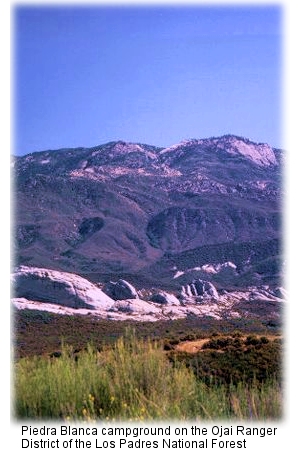 During the past 30 years, according to the
During the past 30 years, according to the 
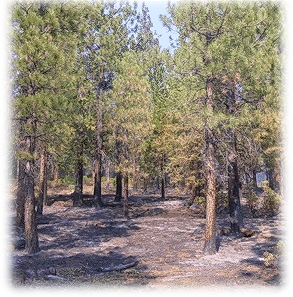
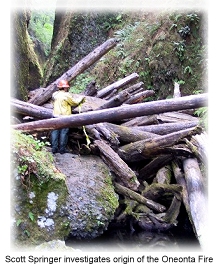 Jimmye Turner, information officer with the Type 2 team managing the Bowl Fire, said the fire was 95 percent contained yesterday, with 392 firefighters on the fire. Two dozers cut line on a relatively flat ridge on the southwest portion of the fire, and firefighters in the afternoon climbed down steep canyon slopes with driptorches to burn out the perimeter.
Jimmye Turner, information officer with the Type 2 team managing the Bowl Fire, said the fire was 95 percent contained yesterday, with 392 firefighters on the fire. Two dozers cut line on a relatively flat ridge on the southwest portion of the fire, and firefighters in the afternoon climbed down steep canyon slopes with driptorches to burn out the perimeter.
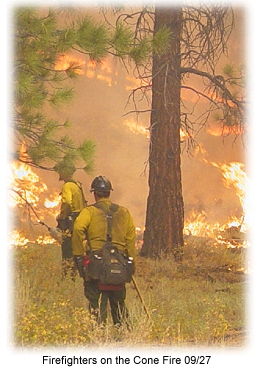 SEPTEMBER 28 -- SUSANVILLE, CA: More than 600 firefighters are on the lines of a timber fire on the Lassen National Forest and private lands northwest of Susanville near Black's Mountain. The Cone Fire was 40 percent contained last night at 1,895 acres,
SEPTEMBER 28 -- SUSANVILLE, CA: More than 600 firefighters are on the lines of a timber fire on the Lassen National Forest and private lands northwest of Susanville near Black's Mountain. The Cone Fire was 40 percent contained last night at 1,895 acres,
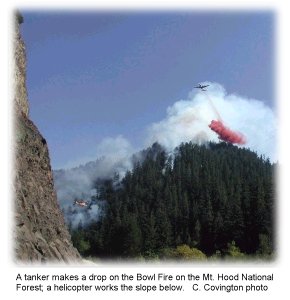 Mike Ferris with the Forest Service's Columbia River Gorge National Scenic Area said crews from Corbett and Cascade Locks were on the fire with firefighters from ODF and the U.S. Forest Service. Firefighters had to climb up the steep eastern slope of Oneonta Gorge to reach the fire, and a helicopter was diverted from the Bowl Fire to help. Police closed off access along a seven-mile stretch of the Historic Columbia River Highway.
Mike Ferris with the Forest Service's Columbia River Gorge National Scenic Area said crews from Corbett and Cascade Locks were on the fire with firefighters from ODF and the U.S. Forest Service. Firefighters had to climb up the steep eastern slope of Oneonta Gorge to reach the fire, and a helicopter was diverted from the Bowl Fire to help. Police closed off access along a seven-mile stretch of the Historic Columbia River Highway.
 He hasn't been seen since.
He hasn't been seen since.

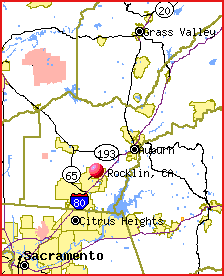 The Sierra Fire, estimated last night at 600 acres, is on the Nevada-Yuba-Placer Unit of the California Department of Forestry near Rocklin. The fire's burning in brush and oak woodland, and road closures and mandatory evacuations are in effect for subdivisions in the Rocklin and Loomis areas. The
The Sierra Fire, estimated last night at 600 acres, is on the Nevada-Yuba-Placer Unit of the California Department of Forestry near Rocklin. The fire's burning in brush and oak woodland, and road closures and mandatory evacuations are in effect for subdivisions in the Rocklin and Loomis areas. The 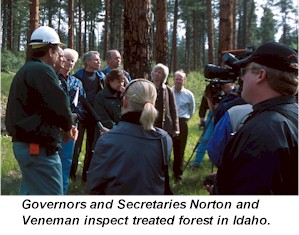 "The 10-year plan makes it clear that the forest health treatments are to be done in a way that meets federal environmental laws," said Kitzhaber. He noted that while the Bush administration has "put tremendous energy" into finding ways to shortcut environmental protections, it has consistently cut funding for National Fire Plan projects, according to a story in the
"The 10-year plan makes it clear that the forest health treatments are to be done in a way that meets federal environmental laws," said Kitzhaber. He noted that while the Bush administration has "put tremendous energy" into finding ways to shortcut environmental protections, it has consistently cut funding for National Fire Plan projects, according to a story in the